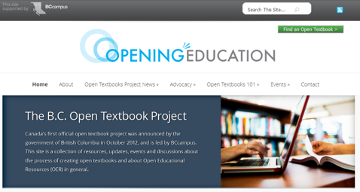This year marks the tenth anniversary of the launch of the B.C. Open Textbook Collection. In this monthly blog post series we’re looking back and highlighting some significant milestones of the project.
Post by Clint Lalonde, project manager, Open Education Project Manager at BCcampus
Although the B.C. open textbook project was announced in the fall of 2012, 2013 was the year when the project really began to gather steam.
The scope of the original project was to create a repository of 40 openly licensed textbooks that aligned with the top 40 enrolled subject areas in B.C., so the first task was to figure out what those top 40 subject areas were. Using data collected from the 25 institutions and the Ministry of Advanced Education data warehouse, we came up with a list of first- and second-year high-enrollment subjects and settled into the task of finding or creating books that could be used in those areas.
One way we did this was by working intentionally with other open textbook projects that had begun around that time. In the spring of 2013, we convened a small gathering of organizations working on open textbooks in Vancouver for the very first Open Textbook Summit. The intent of this meeting was to begin collaborating on what resources were out there — to compare lists of books we had, see where the gaps were, and try to coordinate the production of books to fill those gaps. In addition, it was an opportunity to further develop critical relationships with other North American open education projects such as OpenStax, the University of Minnesota Open Textbook Library (now the Open Textbook Network), the Washington Open Course Library, Creative Commons, and student groups such as the Canadian Alliance of Student Associations.
There were many tangible outcomes from that first Summit (which became a staple spring event for a number of years before it morphed into the biennial Cascadia Open Education Summit), including development of a coordinated book-review system. Book reviews were considered essential to the success of the project. In fall 2013 we issued our first call for reviewers, and we published our first open textbook reviews by the end of that year.
The year 2013 also saw significant developments on the technological aspects of the project. We developed and launched the first instance of the open textbook repository and by the end the year had 28 textbooks in it.

2013 also saw our relationship with Pressbooks begin after BCcampus chose to self-host an instance of the web-publishing platform, which is built on the popular WordPress content management platform and is a service we continue to offer and support for post-secondary educators in B.C.
To guide our work, in 2013 we also established the open textbook sub-committee, made up of representatives from the B.C. post-secondary system. This group was instrumental in providing guidance and feedback in the early years of the project to ensure the work being done by BCcampus was aligned with the priorities and vision of the institutions in B.C.
By the end of that year, we began to see some success with the project. The first reported adoption occurred in fall 2013 by Dr. Takashi Sato, a Physics instructor at Kwantlen Polytechnic University, who adopted an OpenStax Physics textbook. At year end we had reports from 12 instructors in the province who had adopted an open textbook, resulting in student savings of over $60,000 on textbook costs.

Stay tuned for the next post in our B.C. Open Textbook Collection Through The Years series as we revisit the milestones from 2014. Always get the latest information on news and events by subscribing to the BCcampus newsletter.
